Chapter III: Minnesota, Sinclair Lewis, and Jewish Bikers
of Travels with Samantha by Philip Greenspun
"Duluth! The word fell upon my ear with a peculiar and indescribable
charm, like the gentle murmur of a low fountain stealing forth in the
midst of roses; or the soft, sweet accents of an angel's whisper in the
bright, joyous dream of sleeping innocence."
--- James Proctor Knott, in the House of Representatives, 1871
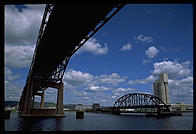
Wednesday, June 2
 You might have toured Venice in a gondola, trekked the Himalayas, and
slept in the Louvre, but you haven't lived until you've been on a
cruise around
Duluth's
harbor. Here is the magnificent industrial face of America that is so
often hidden from Easterners. Duluth's industry is storing stuff that
comes in by rail from the Heartland and loading it onto boats for
shipment to the Great Lakes region, the East, and the World. Massive
grain elevators and iron ore docks are numerous, but the city's pride is
a new mountain of coal emptied by a $200 million German-built conveyor
system
You might have toured Venice in a gondola, trekked the Himalayas, and
slept in the Louvre, but you haven't lived until you've been on a
cruise around
Duluth's
harbor. Here is the magnificent industrial face of America that is so
often hidden from Easterners. Duluth's industry is storing stuff that
comes in by rail from the Heartland and loading it onto boats for
shipment to the Great Lakes region, the East, and the World. Massive
grain elevators and iron ore docks are numerous, but the city's pride is
a new mountain of coal emptied by a $200 million German-built conveyor
system
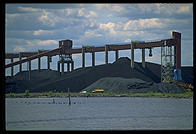 that won the Civil Engineering Award, previously given to the Hoover Dam
and the Golden Gate Bridge.
that won the Civil Engineering Award, previously given to the Hoover Dam
and the Golden Gate Bridge.
Kirk, a good looking Scandinavian-American college kid, filled me in on
life in his hometown.
"Lake Superior is 400 miles long. Even now the water isn't above 37
degrees. When the wind comes off that water, you get a wind-chill of
-100 degrees. The economy is dead flat due to the collapse in iron ore
mining. Once I finish my manufacturing management degree, I'm moving to
Colorado."
Why Colorado?
"I lived there for one year in high school, and it beats Hell out of Duluth."
Town Babbitts are not giving up without a fight. They spent $20
million to build a container handling terminal; it was used once for a
demonstration 10 years ago. They spent $15 million for a fine
convention center; it is in Duluth. They turned a brewery on the lake
into a Ghiradelli Square upscale shopping mall clone; it was empty.
You won't begrudge the Feds those gas tax dollars if you get back on
an Interstate highway after a few days of hard travel on two-lanes.
I-35S to
Minneapolis
makes for lovely driving, if a bit dull due to
the lack of towns, hills, lakes, or color in the trees. The only thing
that breaks up the monotony are the occasional casinos! That's right,
the Indians are sovereign and, with partners from Las Vegas, operate
huge casinos for Minnesotans. The result is Vegas without the
high-rises and Mafia feel.
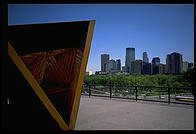
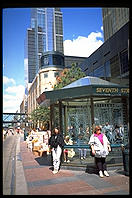 The Twin Cities rise up like Oz out of the flat landscape,
"divided by the Mississippi River and united by the belief that the
inhabitants of the other side of the river are inferior."
The Twin Cities rise up like Oz out of the flat landscape,
"divided by the Mississippi River and united by the belief that the
inhabitants of the other side of the river are inferior."
Minneapolis went whole hog for mirrored-glass megaliths, which isn't
so bad; Mies van der Rohe looks a lot better after staring at trees
for 15 hours. Everything works here to an appalling degree. The
bus shelters are beautiful glass gazebos with piped-in classical music
(nice Mozart and Chopin; no angst-inducing Mahler here). Buses run on
time. People would be shocked to pay a crushing tax burden and
receive nothing in return.
This is an UnCity in many ways. A fundamental difference between
village life and city life is that primary relationships are replaced
with functional relationships. In the village you buy your food from
Bob, whom you've known since childhood, who happens to be working in
the supermarket. In the city you buy your food from a supermarket
clerk whom you could see every day and never learn his name.
Minneapolitans haven't understood this. When you walk into a store or
a restaurant, people say hello to you, unlike in Boston, where they'd
wait for you to approach them and attempt to transact business. Here
you relate as people first, as consumer and vendor second.
 Moll Flanders would have had a delightful time here: natives are
woefully unprepared for the sort of malevolent self-invention that is
possible in cities. At a touring performance of Aspects of
Love, I sat next to a local family. One of the daughters had lived
her whole life in Minneapolis; she invited me to come visit the next
day and go sailing. Her sister, though so clear of eye and smooth of
skin that it would be difficult to believe that anything bad had ever
happened to her, had been schooled in suspicion and human evil at
Harvard Law School. She remembered an intangible obligation for the
benefit of her naive sister and nixed the invitation.
Moll Flanders would have had a delightful time here: natives are
woefully unprepared for the sort of malevolent self-invention that is
possible in cities. At a touring performance of Aspects of
Love, I sat next to a local family. One of the daughters had lived
her whole life in Minneapolis; she invited me to come visit the next
day and go sailing. Her sister, though so clear of eye and smooth of
skin that it would be difficult to believe that anything bad had ever
happened to her, had been schooled in suspicion and human evil at
Harvard Law School. She remembered an intangible obligation for the
benefit of her naive sister and nixed the invitation.
Oh yes, even if you don't care for Andrew Lloyd-Webber, try to see
Aspects of Love. It is more than your average love
pentalateral with incest.
To the extent that anonymity and functional relationships are beginning
to prevail here, it distresses people as much as it might have an
18th-century Londoner. I walked into a Vietnamese restaurant in artsy
Uptown. The only other customers were Eric and Laurel, who looked a bit
like movie actors. Eric had short blond hair over a trim but solid
Midwestern build. Laurel had leggy delicate features and a sideways
baseball cap over long blond hair. They cooked gourmet food for a
bed-and-breakfast in a Wisconsin town an hour from Minneapolis.
Although they looked quite happy with each others' company, Laurel
immediately greeted me with a friendly "hello," and we started to chat
about their life in a community of 175 versus their old life in the
city.
Didn't they miss the potential for human contact in the city?
"I lived here for three years, and I think it is much harder to meet
people in a city," noted Eric. "Everyone knows everyone else in our
village, and people park with the keys in the ignition."
"It isn't as backward as you might think. We have intellectuals in our
town who live semi-communally and home-school their children," Laurel
added.
How was it working out?
"We were skeptical at first, thinking that kids needed to be socialized
with each other, but the home-schooled children seem so much happier,
better adjusted, and better educated than factory-schooled children."
I parted from Laurel and Eric with an invitation to drop in anytime they
had a spare room.

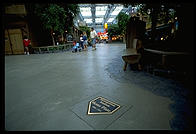 I thought that the Canadians had us beat in mall culture, but that was
before I drove 20 minutes south to the Mall of America, formerly a baseball stadium,
where over 12,000 people work and 100,000 shoppers can roam in
comfort. The central courtyard comfortably accommodates a Snoopy
theme park with roller coaster, and stores have street addresses. It
was a disappointment, however. Instead of 10 times as much variety,
the mall just has 10 near-clones of each type of store. There are
plenty of things that one can't buy in the mall--even Berlin's KaDeWe
department store has a broader range of goods.
I thought that the Canadians had us beat in mall culture, but that was
before I drove 20 minutes south to the Mall of America, formerly a baseball stadium,
where over 12,000 people work and 100,000 shoppers can roam in
comfort. The central courtyard comfortably accommodates a Snoopy
theme park with roller coaster, and stores have street addresses. It
was a disappointment, however. Instead of 10 times as much variety,
the mall just has 10 near-clones of each type of store. There are
plenty of things that one can't buy in the mall--even Berlin's KaDeWe
department store has a broader range of goods.
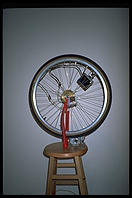
|
Minneapolis outhips New York with an updated Duchamp bicycle wheel in the Walker Art Center
|
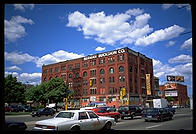
|
Continuing my research into Jewish settlement of the Midwest...
|
Friday, June 4
I breakfasted with Al, an attorney originally from Brookline, Massachusetts.
"I came out here to work for the attorney general for a summer and then
decided to settle here. What shocked me about Minneapolis was that
people had faith in the system. No assumptions were made about the
kinds of people who were arrested. It wasn't just the prosecutor's
office or the judicial system. People believe in the government school
system here.
"Life here is working out for me. My main problem now is that I'm upset
with myself. I spent a lot of my life pushing race-based affirmative
action, and now I'm beginning to think it is a mistake. I don't think
Clinton is making a good choice in nominating a civil rights attorney
general."
Al was referring to a vigorous public debate of which I'd been
blissfully unaware. My increasing habit of ignoring newspapers was
catching up with me. After breakfast, I drove out to St. Paul's
Cathedral, a reasonably faithful copy of Rome's St. Peter's. Four
mosaics under the dome celebrate cardinal Midwestern virtues: Justice,
Fortitude, Temperance, and Prudence. Any Italian will tell you that
one of the most important things about St. Peter's is that there are
no paintings; it is decorated with more impressive stone carvings,
sculptures, and mosaics. Yet somebody incongruously stuck a single
oil painting on one of the cathedral walls here.
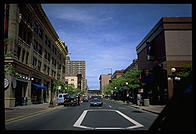 A quick ride downhill to downtown St. Paul was enough to convince me
that St. Paul is Minneapolis's plain sister. The few nice towers are
separated by horribly ugly 1950s and '60s concrete monsters.
Although St. Paul is the state capital, the taste mavens at the
Federal Reserve Bank chose to locate their magnificent modern palace
in downtown Minneapolis, upstream on the other side of the
Mississippi, 15 minutes away by Interstate. About St. Paul, one might
fairly say that there is no "there" there.
A quick ride downhill to downtown St. Paul was enough to convince me
that St. Paul is Minneapolis's plain sister. The few nice towers are
separated by horribly ugly 1950s and '60s concrete monsters.
Although St. Paul is the state capital, the taste mavens at the
Federal Reserve Bank chose to locate their magnificent modern palace
in downtown Minneapolis, upstream on the other side of the
Mississippi, 15 minutes away by Interstate. About St. Paul, one might
fairly say that there is no "there" there.
Heading northwest on I-94 listening to Minnesota Public Radio's noontime
classical program, the rolling hills unfolded before me under patchy
clouds and 65 degrees. I ate lunch in Sauk Centre, population 4000, with
Wendy and Angie, two recent high school graduates. Solid
German-American girls born and raised in this agricultural village, they
hated having all of their secrets known and believed. They were ready
to move away to college and cosmetology school, but not ready for
anything as big and far away as the Twin Cities.
"Life here is really boring. School is boring and really easy. A lot
of people drink and smoke dope."
"What about all those `DARE to keep kids off drugs' T-shirts everyone
here seems to wear?" I asked.
"Well, probably more than half of our high school class has tried
marijuana."
So they thought Sauk Centre was losing the War on Drugs?"
"I wouldn't say that. I bet we'll be the last generation of dope
smokers."
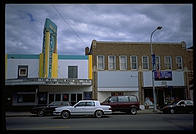 It is usually easy to forget America's Calvinist heritage, but Sauk
Centre will shove it in your face. Calvinists take seriously the
notion that ultimate judgment is reserved for God. We might be
convinced that we are right, but there is always a trace of doubt.
This kept anyone from being beheaded in the American Revolution
(contrast that with the revolution in humanist France). On the other
hand, sometimes showing both sides of the coin leads to bizarre
results. In Germany, I'd sometimes asked why there weren't any Nazi
museums and people said, "Don't be ridiculous; why would we promote
something we should be ashamed of?" Folks in Sauk Centre just
wouldn't understand this.
It is usually easy to forget America's Calvinist heritage, but Sauk
Centre will shove it in your face. Calvinists take seriously the
notion that ultimate judgment is reserved for God. We might be
convinced that we are right, but there is always a trace of doubt.
This kept anyone from being beheaded in the American Revolution
(contrast that with the revolution in humanist France). On the other
hand, sometimes showing both sides of the coin leads to bizarre
results. In Germany, I'd sometimes asked why there weren't any Nazi
museums and people said, "Don't be ridiculous; why would we promote
something we should be ashamed of?" Folks in Sauk Centre just
wouldn't understand this.
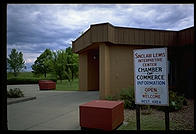 Any town might be proud of a son who won
the 1930 Nobel Prize for literature, the first American to do so.
But what if he won that prize by writing Main Street, a book
about how venal and narrow-minded the townspeople of "Gopher Prairie" are? Sinclair Lewis
was born here in 1885 and left to go to Yale, travel the world, and
settle in New York. His boyhood home is now on Sinclair Lewis Avenue.
Main Street has been renamed "Original Main Street". There are banners
all up and down this inspiration for Lewis proclaiming its status as
such. Weirdest of the weird was visiting the Chamber of Commerce
Sinclair Lewis Interpretive Center.
Any town might be proud of a son who won
the 1930 Nobel Prize for literature, the first American to do so.
But what if he won that prize by writing Main Street, a book
about how venal and narrow-minded the townspeople of "Gopher Prairie" are? Sinclair Lewis
was born here in 1885 and left to go to Yale, travel the world, and
settle in New York. His boyhood home is now on Sinclair Lewis Avenue.
Main Street has been renamed "Original Main Street". There are banners
all up and down this inspiration for Lewis proclaiming its status as
such. Weirdest of the weird was visiting the Chamber of Commerce
Sinclair Lewis Interpretive Center.
"I thought Sinclair Lewis had particular scorn for the kinds of
boosters who formed the Chamber of Commerce. How come they built this
nice highway rest stop for their most vicious satirist?" I asked the
woman running a biographical video.
"I don't know. I haven't read any of his books."
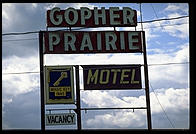
My AAA Triptik lavishly praises most of the country through which I'd
roamed, but about western Minnesota and eastern North Dakota, the only
thing nice they could find to say was that the highway has "good
alignment and grade" (i.e., it is ruler straight and pancake flat).
It is true that eastern North Dakota is flat enough that radio
stations could mount their antennae on the roof of an old Chevy. But
there is real beauty in the open grasslands, numerous grass-filled
ponds, and extensive sky.
Tonight was my first night camping. There is nothing like a full moon
overhead, prairie grass underneath, 20 miles of separation from the
nearest houses, and ... the sound of 2000 Harley-Davidsons. Yes, I was
at a motorcycle rally where the free spirits of North Dakota convene,
leather-clad and helmetless.
"You can park your cage over there," waved a young woman.
"What's a `cage'?" I asked.
Everyone broke into uproarious laughter and passed the joke through the
local crowd. It turned out that any kind of car is a "cage"--thus did I
augment my previous store of biker wisdom and lingo, which had been
limited to the aphorism "Better your sister in a whorehouse than your
brother on a Honda."
With assistance from the first passerby, I pitched my tent in the
Caravan's headlights. It was after 11:00 PM when I strolled around the main
portion of the rally, where people were getting tattoos and dancing to a
live band. Free beer lubricated social intercourse.
"Are neo-Nazi groups as popular out here as the media would have us
believe?" I started a conversation with a young woman.
"I've never seen any except on television," she replied while sipping a
Coke. "Our lives are centered around children, church, movies, and
riding our Harleys whenever we can. My husband works as a welder, I
stay home with the kids, and we live in a community of 100. It's a very
quiet existence."
Has she thought about moving?
"I've lived a lot of places, but North Dakota is the best. A few people
say they are tired of it here and talk about leaving, but they
never do. We don't have the kind of crime and craziness that you
see in big cities. People stick together and have a real sense of
community."
Determined to stir the pot, I pointed out that Bismarck, the state
capital, has only 1/200th the population of Los Angeles or New York and
therefore it wasn't surprising that there were fewer and less
interesting crimes. My interlocutor wasn't offended, though. Despite
their often formidable appearance, North Dakota bikers are a gentle
group. Only once was I ever afraid of any of the rally participants.
He was a 6' 3", 240 lb. guy with a black beard and a beer gut poking
out from under his black Harley T-shirt. At about 7:30 AM, he roughly
shook a nearby camper awake and demanded, "Are you a Jew?" The sleeper
said, "No," and the big guy moved to the next tent, asking the same
question. By the time he got to me, I was concerned, but I nervously
answered, "Yes." He said, "Great! We need a tenth for a minyan."

 Chapter IV: Yellowstone
Chapter IV: Yellowstone
 Table of Contents
Table of Contents
philg@mit.edu
Related Links
Add a comment | Add a link
 You might have toured Venice in a gondola, trekked the Himalayas, and
slept in the Louvre, but you haven't lived until you've been on a
cruise around
Duluth's
harbor. Here is the magnificent industrial face of America that is so
often hidden from Easterners. Duluth's industry is storing stuff that
comes in by rail from the Heartland and loading it onto boats for
shipment to the Great Lakes region, the East, and the World. Massive
grain elevators and iron ore docks are numerous, but the city's pride is
a new mountain of coal emptied by a $200 million German-built conveyor
system
You might have toured Venice in a gondola, trekked the Himalayas, and
slept in the Louvre, but you haven't lived until you've been on a
cruise around
Duluth's
harbor. Here is the magnificent industrial face of America that is so
often hidden from Easterners. Duluth's industry is storing stuff that
comes in by rail from the Heartland and loading it onto boats for
shipment to the Great Lakes region, the East, and the World. Massive
grain elevators and iron ore docks are numerous, but the city's pride is
a new mountain of coal emptied by a $200 million German-built conveyor
system
 that won the Civil Engineering Award, previously given to the Hoover Dam
and the Golden Gate Bridge.
that won the Civil Engineering Award, previously given to the Hoover Dam
and the Golden Gate Bridge.












